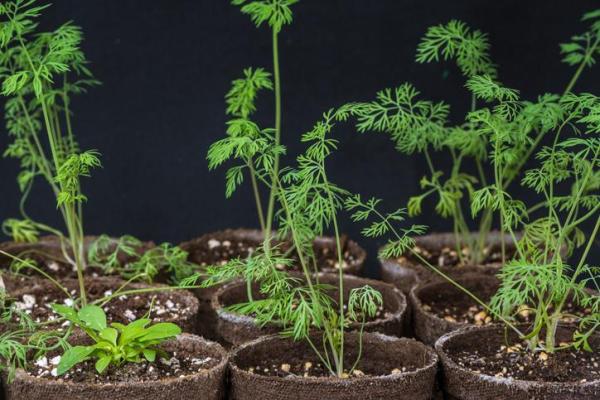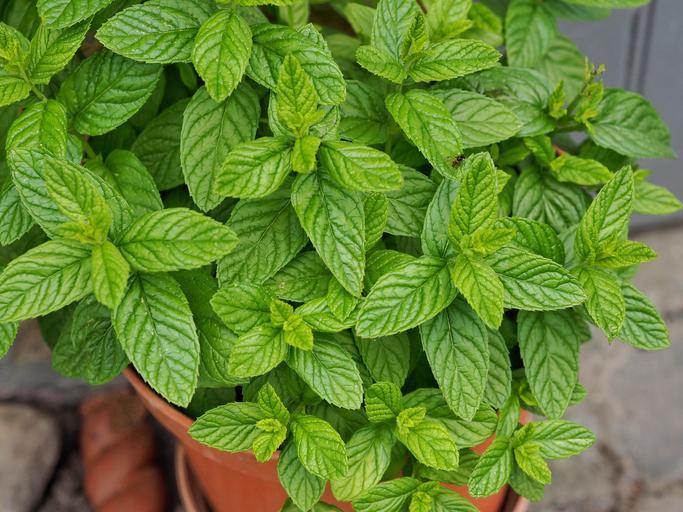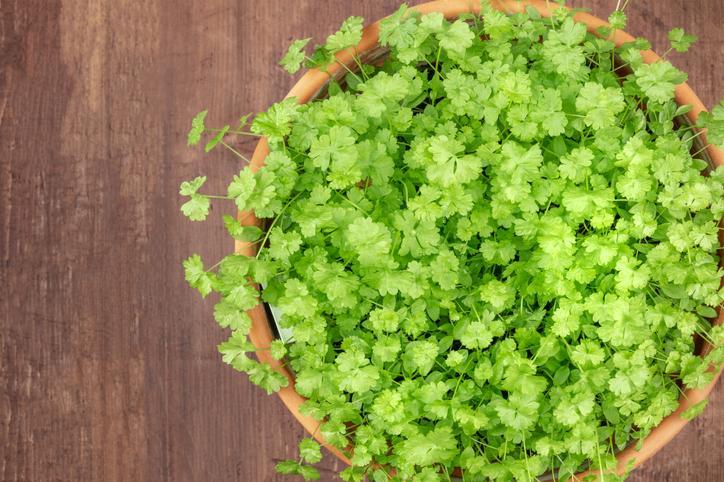Best Aromatic Indoor Plants


Cultivating aromatic indoor plants has various benefits for the home. Firstly, the foliage and flowers of these plants can add an aesthetic beauty which even those with a poor sense of smell can enjoy. Those blessed with sufficient olfactory ability will also enjoy the lilting aromas which can turn your home into a fragrant haven. Many of these aromatic plants also have many beneficial practical uses, especially for those of us who enjoy cooking.
thedailyECO provides our list of the 11 best aromatic indoor plants for the home. You can consider which of these best smelling plants are ideal for your home, especially if you want to put them to practical use in the kitchen.
- Basil
- Cilantro
- Tarragon
- Dill
- Spearmint
- Lavender
- Laurel
- Peppermint
- Parsley
- Rosemary
- Thyme
- How to care for indoor aromatic plants
1. Basil
Basil is one of the most used aromatic herbs in Italian cooking for its freshness and flavor, but above all for its intoxicating aroma. As a potted plant, basil which will brighten up any corner of your home, needs little care to stay in good condition, is always fresh and gives off a very pleasant perfume. You just need to place it in a place where it does not get direct sunlight and ensure it is placed in a well-drained pot.

2. Cilantro
Also known as coriander, cilantro is another of the best aromatic plants for cooking. It requires very little care on your part, but the rewards are innumerable. Cilantro plants prefer to grow in a semi-shaded place, with a light substrate and where there are no drastic changes in temperature. Coriander is one of the most used aromatic plants in various cuisines, including Mexican, Korean, Japanese and many other culinary traditions.

3. Tarragon
Although it is also a fragrant plant that is used in cooking, tarragon is not as well known as the previous entries on our list of the best aromatic indoor plants. It is usually used as a dressing in sauces to give them a touch of aroma, especially in salad dressings or even as an additional leave to the salad itself.
Despite not being as common as other aromatic herbs, potted tarragon care is also relatively straightforward. You just have to make sure that it is in a place with lots of light, with good drainage and remember that it does not well tolerate environmental humidity, waterlogging of the earth or frost.

4. Dill
In addition to being used in the kitchen, especially to combine with fish such as salmon, dill is a plant also used in some traditions for its perceived medicinal properties. Many of these properties are not medically supported, but it is undoubtable that the freshness and herbaceousness of dill can make almost any indoor space seem more alive.
Like the other indoor aromatic plants, indoor dill is a plant that only needs moderate watering. It should be situated somewhere where it gets regular sunlight, but should avoid direct contact with UV rays.

5. Spearmint
Spearmint is one of the most used aromatic plants in international cuisine. In addition to offering an exquisite aroma to our dishes, drinks and our home, it is a very decorative indoor aromatic plant. Spearmint only needs a sunny place to grow and its leaves will take on that characteristic bright green. In addition to being one of the best smelling fragrant plants, it is also a great plant for absorbing moisture in the home.

6. Lavender
Lavender is one of the most used aromatic plants for interior decoration. It is prized not only for its elegant flowers, but for its soft aroma which will permeate the air in a gentle way. Many people find lavender to be one of the most relaxing aromatic plants, but it is also great for making a summer day smell all the more sweeter.
If you want more specific information about caring for this beautifully fragrant indoor plant, check out our guide on caring for potted lavender.

7. Laurel
Also known as a bay tree, laurel trees are outdoor plants which can grow to staggering heights. Sometimes as high as 50 feet. For this to happen, they need very specific conditions and climates. Although it is possible they can grow too tall for your inside spaces, we can also grow potted laurel as an aromatic indoor plant. By keeping them in the right-sized pot, we can have these beautiful trees indoors.
To make use of the fragrant leaves for cooking, we simply have to prune some healthy ones and leave them to dry in the sun. Once completely dehydrated, we can keep them in a sealed bag and add them to soups, stews and even rice as it cooks. They can grow with relatively little light and they should never be overwatered.

8. Peppermint
Various types of mint can be used to add some beautiful aromas to the home, with peppermint being known for its slightly spicy scent. It is one of the most used aromatic plants in confectionery due to its strong aroma and fresh flavor. As with spearmint, peppermint needs regular watering, a rich substrate, a pot with good drainage and to be placed in a bright area of the house.
You can also grow this hardy plant in outdoor environments. See how you can provide benefit to these plants with our guide to the best organic fertilizers for the garden.

9. Parsley
The parsley plant is used in so many Mediterranean cooking recipes and it is also a very easy plant to grow in a pot. It only requires semi-shade and regular watering so that the substrate is always somewhat humid. It is advisable to have the potted parsley indoors on a regular or permanent basis to avoid sudden changes in temperature.

10. Rosemary
Although rosemary is an outdoor shrub, we can also have it inside our house. The only thing you need is to place it in an open-air place, such as right next to a window that you open regularly. Similarly, it should receive sunlight for as long as possible. Rosemary is considered a sign of good luck and fortune for the home in various traditions, but it is most commonly used as a herb for various dishes. Since its leaves are hardier than many of the aromatic indoor plants on our list, it is particularly good for roasting in the pan or oven.
See which is best for you with our guide to different types of rosemary plants.

11. Thyme
Finally, we also want to talk about thyme plant, a small-leaved aromatic plant that we can also have indoors and that is the perfect accompaniment to rosemary. It does not need much care, you just have to be careful that it does not accumulate moisture and that the container where you have it has good drainage. As with rosemary, it is also very hardy and you can place whole stems into various dishes to give a rich aromatic flavor.

How to care for indoor aromatic plants
Whether aromatic or not, plants can be grown outdoors in the right climate. Many of us either don't have the right climate to grow some of the best smelling aromatic plants or simply don't have the access to a garden. In these cases, growing them indoors is ideal, especially since we can better control their ambient environment. This means plants which require regular irrigation can be given plenty of water, even if it is dry outside.
Caring for indoor aromatic plants is relatively simple, but some plants are more sensitive than others. While every individual plant species will have their own specific care needs, there are some general guidelines you can follow when you want to cultivate potted aromatic plants:
- The first thing will always be to identify the individual needs of each species and group similar plants together. Prioritize those whose life cycles are the same and separate perennials from biennials and annuals.
- If you group them by their irrigation needs, you will also make their care much easier. Although they tend to be undemanding in this regard, not all of them need the same amount of water. At this point it is always better to give less than to oversaturate their substrate. This is because these small plants tend not to tolerate excess moisture.
- Take advantage of the fact these are easy-to-reproduce species and make cuttings. These will allow you to have more of these useful and pleasant plants, either to keep them or to give to your loved ones as a gift.
- If you're having trouble and don't know why indoor herbs are dying, pay close attention and look for their individual light, temperature and watering needs. If you keep these three key points in good order and use a well-draining, light and airy substrate, you shouldn't have any problems.
Now you know some of the best aromatic indoor plants to grow inside the home, you may want to consider what is available for outdoor areas. Take a look at our guides to the best white flower plants for the garden and purple flowering plants for the garden to get some inspiration.

If you want to read similar articles to Best Aromatic Indoor Plants, we recommend you visit our Indoor plants category.
















